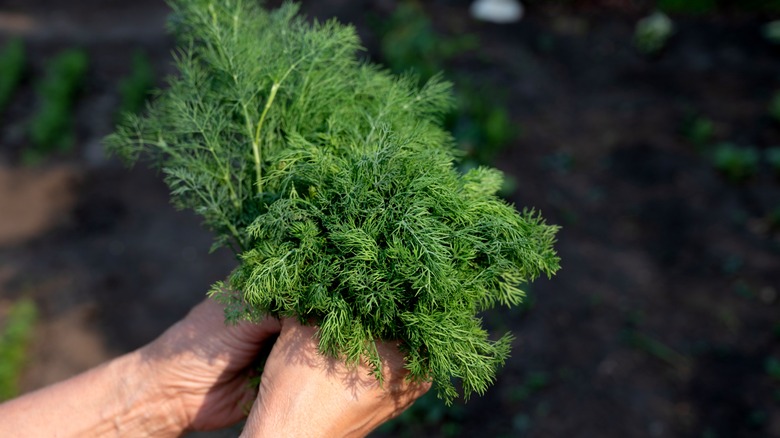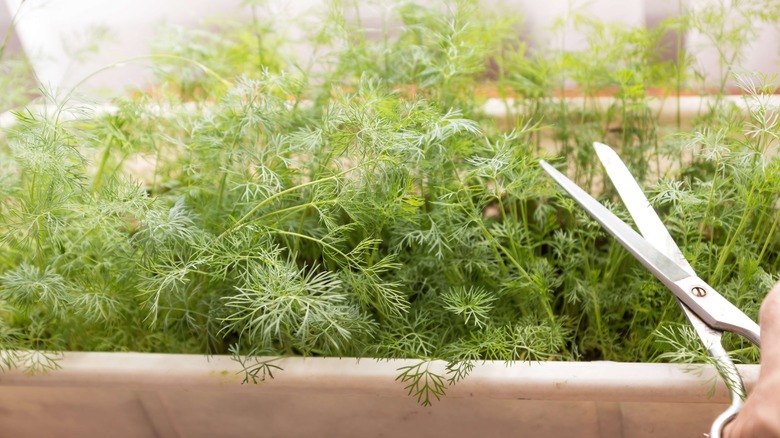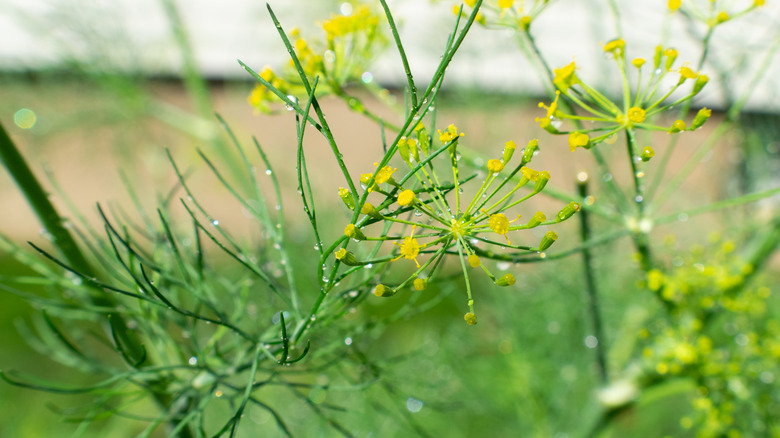How To Prune Dill In Your Garden For A Bountiful Harvest All Season Long
Though grocery prices might not be climbing as rapidly as they were a couple of years ago, the cost of groceries is still steadily increasing. According to the Food Price Outlook for 2024 from the USDA's Economic Research Service, the cost for food-at-home (grocery store or supermarket food purchases) increased by 5% in 2023. While it's unrealistic for most folk to grow, butcher, or make all the food they need from scratch, growing your favorite herbs indoors or outside can save you dollars meal-to-meal — this is especially true when you know how to properly prune your herbs throughout the growing season for the most bountiful harvest possible.
Dill (Anethum graveolens) isn't unlike other tasty herbs grown in planters, raised garden beds, or directly in the soil. Similar to how pruning your basil plant is key to maximum yield, properly pruning dill will ensure your plants stay healthy and grow more vigorously throughout the season. Remember, while harvesting and pruning can be done simultaneously, they aren't exactly the same. When you harvest dill, you take pieces of the plant for yourself. However, pruning is for the plant, so you must make specific cuts to support its growth and encourage it to flourish. For dill specifically, this means finding stems with at least two leaf sets and cutting just above the bottom leaf set. You can do this as many times as necessary; however, be sure you don't prune the plant down further than two-thirds of its original size.
How to prune dill
Pruning dill stems to the previous leaf set is a good rule of thumb. However, many questions are still unanswered. Let's say you directly sowed your dill seeds outdoors in the spring. In this scenario, it will take a week for the seed to germinate and several more before it's ready to be harvested. Typically, within two months, your dill plant should be a few inches tall with multiple sets of thin, feathery leaves, marking the time to begin pruning. Even if you don't have a meal in mind to use your freshly harvested dill, you should still take the time to prune the plant as foliage grows. Ignoring the herb may only cause it to flower sooner, which will make it much more difficult — if not impossible — to reap a large harvest by the end of the growing season.
As you care for your dill plant, your main goal is to keep it from bolting and flowering. Letting the flowers flourish is among the biggest mistakes people make when growing herbs. You must prune the flower stalks as they begin to form to delay flowering and encourage more leaf growth. Failing to do so won't just cause the plant to redirect its leaf-growing energy to the budding flowers, but any leaves following the blooms will be less flavorful. Along with regular pruning, ensuring that your dill's soil remains moist and shading it from the hot afternoon sun will decrease the chances of bolting.
Other considerations for pruning and harvesting dill
Like with most gardening practices, there are caveats to pruning dill plants. Whether you want multiple plants to grow throughout the season will make a big difference in how you approach pruning dill. The herb has prolific self-seeding abilities, so you'll want to leave some umbrella-like, yellow flowers intact to drop seeds and give way to new plants. However, this isn't the only way to grow more dill with the plants you already have. You can harvest seeds by pruning flower stalks before the seeds turn brown. Since dill grows, blooms, and fades rapidly, you can plant and harvest multiple plants throughout the season if you sow new seeds once or twice monthly.
Another consideration you'll want to make before going to town with your pruning shears is deciding if you should cut longer stalks for use in bouquets. While pruning leaf sets from the top down will help fight leggy growth and improve the bushiness of your dill, cutting stems nearly to the ground with just a few inches of the stalk above the soil is a practice used for floral arrangements. This kind of cut is also useful if you like to store fresh stems in water for easy access in your kitchen. Learning to correctly prune while harvesting your dill plants and other herbs is valuable. You can increase your plants' yields, and tips for harvesting and storing your fresh garden herbs may start to come more naturally to you.


